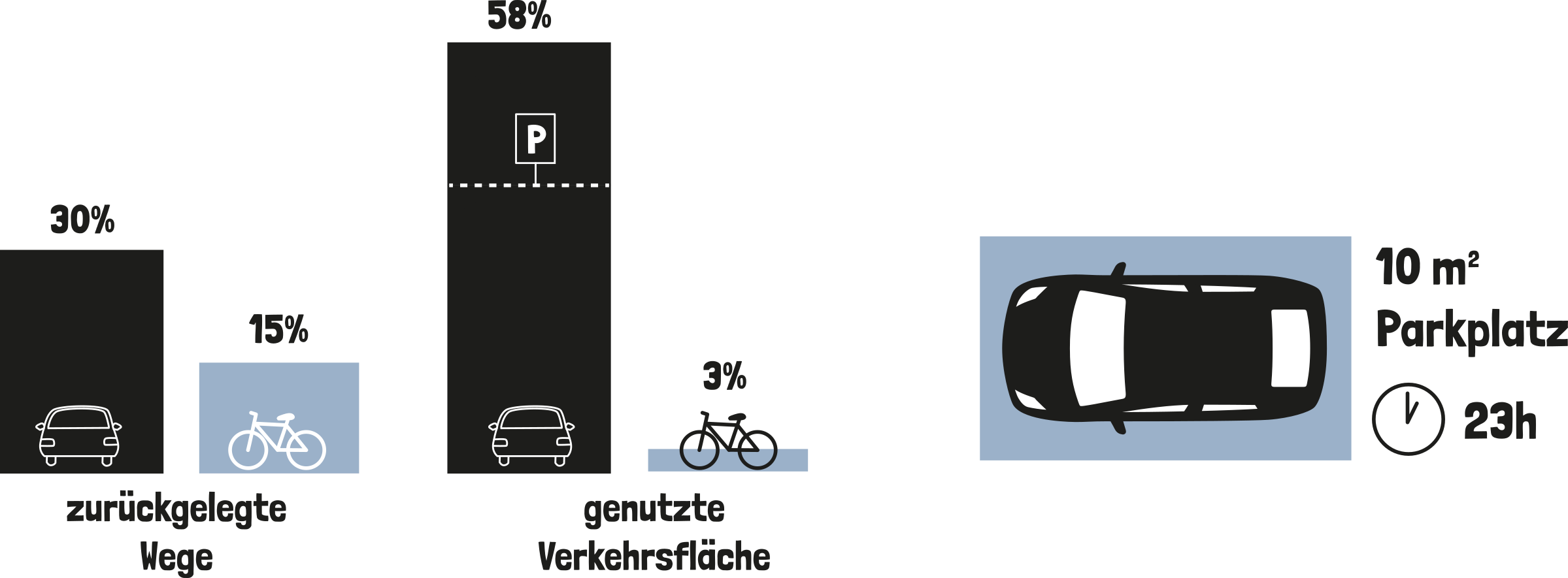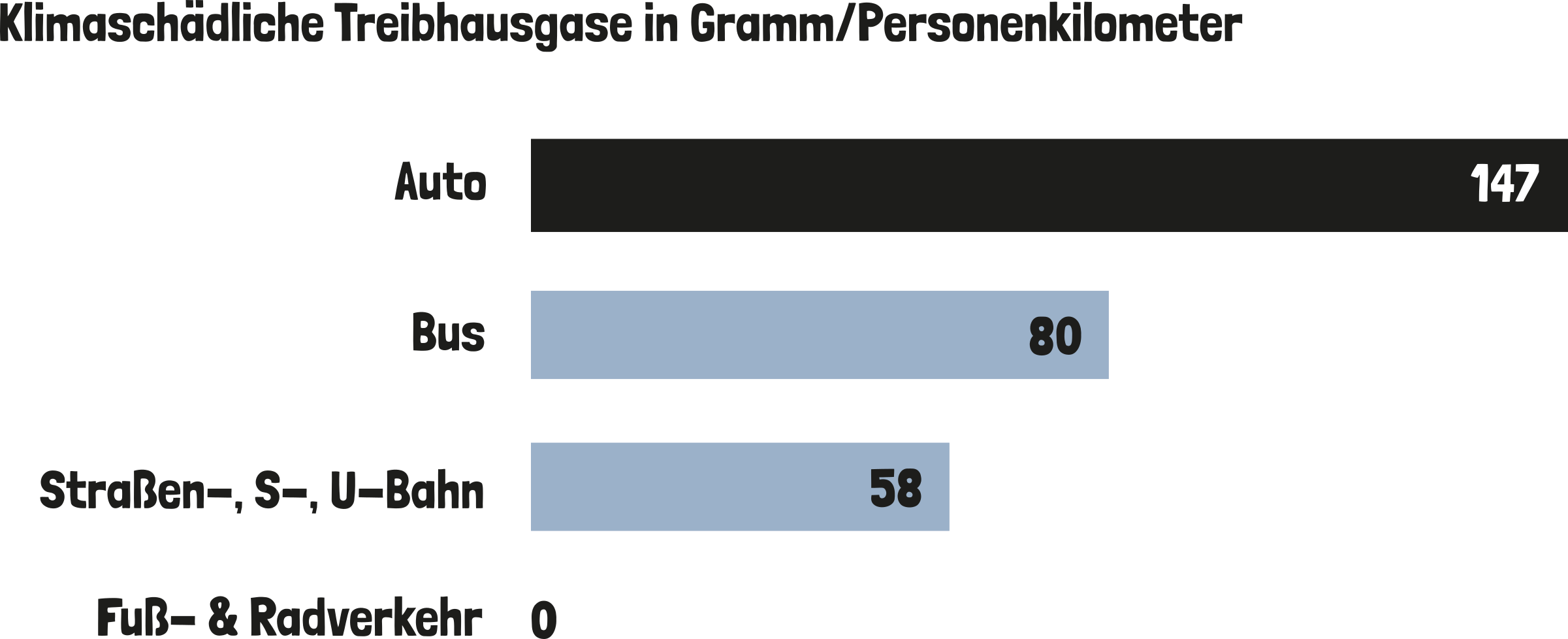five reasons
Why car-free?
A sustainable city needs much more space for pedestrians, cyclists and a strong public transport system.
A car-reduced Berlin city centre ensures:
- better quality of life
- a healthier life
- more space for everyone
- more safety on Berlin’s streets
- climate protection
Electric mobility cannot solve the traffic problems of our cities. After all, an electric car is still a car, with all its problems.
reason
better quality of life
A liveable city puts people at the centre. A city that no longer focuses on the fastest and strongest, but on the slowest and weakest: cyclists, pedestrians, children and the elderly.
A Berlin with fewer cars invites you to take a walk and be outside. Parking spaces become flower beds, children play in the streets, people relax in cafés on the main street, neighbours meet in the newly created Kiezpark. There are no traffic jams, the air is fresh and clear. An exciting, big city, from which you don’t have to flee to enjoy a moment of silence. Let us rethink life in Berlin!
der Menschen in Deutschland wünschen sich, dass Bahn-, Bus-, Rad- und Fußverkehr in ihrer Stadt gestärkt werden.1
der Bevölkerung sehen eine Verbesserung der Lebensqualität darin, wenn der oder die Einzelne nicht mehr auf ein Auto angewiesen ist.1
1) Daten entnommen aus der Umweltbewusstseinsstudie 2016, einer repräsentativen Bevölkerungsumfrage des Bundesumweltministeriums und des Umweltbundesamts
reason
a healthier life
Cars cause major consequential damage to human health and the environment. A city centre with few cars improves air quality, reduces noise levels and thus has an enormously positive effect on the health of everyone.
The Covid-19 pandemic also shows that outdoor exercise is now more necessary than ever for physical and mental health. This requires enough space for physical distancing. Opening the streets to more cyclists and pedestrians is an important step in this regard.
frühzeitige Todesfälle durch verkehrsbedingten Lärm in Deutschland pro Jahr2
frühzeitige Todesfälle durch verkehrsbedingte Emissionen in Deutschland pro Jahr3
2) Schätzungen 2015, Quelle: Mobilitätsatlas Heinrich Böll Stiftung
3) infolge Feinstaub, Ozon und Stickoxiden. Quelle: VCD, 2019
reason
more space for everyone
Public space in the centre of Berlin is a valuable and scarce resource. Everyone should be able to use it. Also the street is there for everyone and not just for the few who drive or park on it.
Cars – parked or driven – take up a disproportionate amount of space. This space is urgently needed: for trains, buses and trams, for wider footpaths and cycle paths, for playing, for neighbourly interaction and public life.
A just allocation of space means redistributing public space in favour of those who want to move around in a healthy and climate-friendly way.

Der Vergleich zwischen Radverkehr und Autoverkehr zeigt deutlich, wie ungerecht die Verkehrsflächen in Berlin verteilt sind. Autos sind außerdem viel mehr Stehzeuge als Fahrzeuge, da sie statistisch gesehen 23 Stunden am Tag einfach nur herumstehen und öffentlichen Raum blockieren.
Quelle: Agentur für clevere Städte, Flächen-Gerechtigkeits-Report, Berlin 2014
reason
more safety on Berlin’s streets
Berlin’s streets must become safer. There are still too many traffic deaths and injuries in Berlin. Especially the weakest must be protected: pedestrians and cyclists. Children and senior citizens in particular should be able to feel safe on Berlin’s streets; otherwise their mobility will be restricted because the risk or fear of an accident is too great.
A car-reduced city centre leads to more safety on Berlin’s streets. The aim is the strict implementation of the Vision Zero (zero traffic fatalities and serious injuries).
im Verkehr schwer verletzte Personen
in Berlin 2019
Verkehrstote
in Berlin im Jahr 2019
getötete Fußgänger*innen
in Berlin 2019
getötete Radfahrer*innen
in Berlin 2019
Verkehrstote
in Berlin im Jahr 2020
getötete Fußgänger*innen
in Berlin 2020
getötete Radfahrer*innen
in Berlin 2020
reason
climate protection
Climate change requires immediate action at all levels, here and worldwide. The burdens of climate change are mainly borne by the global South, although the problem is largely caused by the global North.
In Germany, the transport sector is the only sector that has so far contributed little or nothing to CO2 savings. As long as this continues to be the case, we are living at the expense of the South – a situation that cannot be justified.
A Berlin city centre with few cars contributes to climate protection and climate justice.

an electric car is still a car
Whether diesel, petrol or electric – car traffic in the city brings many problems that cannot be solved even by alternative engines.
Moreover, the production of electric cars depends on large quantities of valuable resources such as aluminium, cobalt, nickel, manganese, copper, lithium and graphite. The exploitation of these resources is already very problematic. It destroys the environment and the livelihoods of indigenous peoples and leads to child labour, war and displacement.
4) Quelle: Umweltatlas (2015) der Senatsverwaltung für Stadtentwicklung und Wohnen sowie Beitrag von Christof Vieweg vom 17.02.2017 in der ZEIT
5) Quelle: Europäisches Parlament, Zahlen und Fakten zur CO2-Emission von Autos
Abbildung: Kupfertagebau in Chuquicamata, Chile. Photo by Dion Beetson on Unsplash